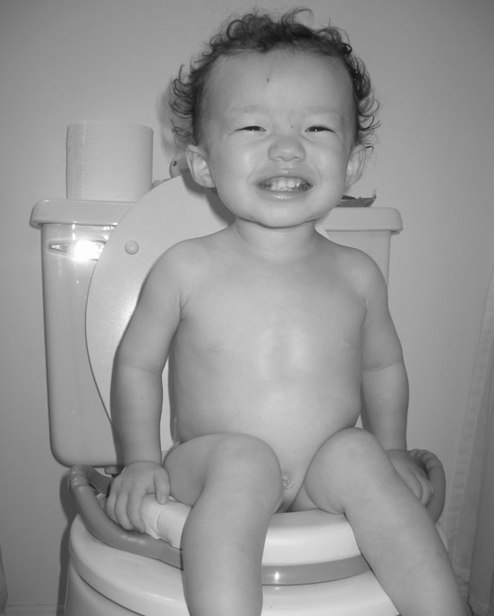The No-cry Potty Training Solution (10 page)
Read The No-cry Potty Training Solution Online
Authors: Elizabeth Pantley

Less Is Best
If you’re lucky enough to begin training in warm weather, or if you can turn the heat up in your home during training, keep your toddler in just training pants for a week or so. Children often resist dealing with all the up and down and on and off required during training, as it takes so much time and effort given their limited abilities. So the less clothing to deal with, the better!
Some parents let their children roam naked during training, but it’s not for everyone. Think about it before you introduce the idea to your little one, because she is likely to love the freedom and may surprise you by doing a little more of it than you planned. You may want to consider your family’s approach to nudity. How are things handled during bathtime? How do you
respond if your child walks in as you are dressing? If your family culture is one of modesty and you suddenly let your child roam the house naked, it may send her some confusing mixed messages.
On the other hand, some families are more relaxed about the body’s natural state. Children, siblings, and parents bathe together, toddlers play in the bathroom as Mommy showers and dresses, and little boys potty

64
The No-Cry Potty Training Solution
Jude, twenty-two months old
train while peeing alongside Daddy. If this describes your family, then you might find a little extra nudie time can help your child become more in tune with her body’s elimination process.
One other thing to think about here is that when using the naked approach, all those early accidents (and there are many) will be unhindered by clothing and
It’s Potty Time! Setting Up
65
land unprotected wherever your child may be, and it won’t be her fault or anything you can prevent. If you have carpeting or furniture that could be ruined by accidents, you might take the training out to the backyard or opt to go the nearly naked approach instead and pop a pair of training pants on your little one.
Training Pants or Disposables?
Once your child has the general idea and has started having daily success on the potty, you may want to switch from diapers or disposable pull-ups to cloth training pants to move things along even quicker.
The drawback to thickly padded disposable diapers or super-absorbent training pants is that they disguise wetness so much that your child probably isn’t bothered by it, whereas cotton training pants, or disposables with a stay-wet liner, signal wetness immediately and aren’t very comfortable to wear when wet or messy. This will help your child become more aware of what’s happening down there.
Also, remember to keep your child’s pants a bit loose so your little one can pull them up and down easily.
Training pants or pull-ups should be a size bigger than necessary. You want them to be manageable for your child, without being so big that they droop.
Make the Bathroom Child-Friendly
Can your toddler easily open the door and turn on the light? Reach the toilet paper? Get up to the sink? If she has a difficult time getting to and using her potty, she will be less interested in using it routinely. Also, if she counts on you to do everything for her, you’ll be miss-66
The No-Cry Potty Training Solution
ing out on a wonderful aspect of potty training: encouraging your child’s independence.
Many young children are leery of empty rooms, and many fear the dark. There’s nothing scarier than the cavern of a dark bathroom at the end of an empty hallway. During the training months, and possibly even for a long time after training, accept that you will either have to accompany your child each time or keep the hallway and bathroom well lit to chase away any unwanted shadows.
Pottying Away from Home
New trainees may be just getting comfortable with the potty routine at home but are unlikely to have the same success in public places or while driving from place to place. It can be frustrating for a parent to have to deal with repeated accidents in the car or while away from home. There are a number of ways to handle being away from home with a child in training.
You can simply decide to keep your child in diapers or disposable pants when away from home. Most children easily adapt to the idea that there is a switch into diapers or pull-ups when you leave the house. Create a routine: the child goes potty and puts on pull-ups before you leave the house and then changes back into training pants or underwear when you return home.
Other options here are to put your child’s diaper or pull-ups over his training pants or use a waterproof diaper cover over his training pants. He may feel happier if he can keep his big boy pants on, yet he’ll feel the wetness if he has an accident. It’s kind of a midstep that can keep you relaxed in the car while helping him see that he is growing up.
It’s Potty Time! Setting Up
67
If you’d prefer not to put your child into diapers when you leave your home, make sure that you are prepared to handle on-the-road potty calls and potty accidents.
Bring along a portable potty for use in the car and a folding seat adapter for use in bathrooms. Cover the car seat with plastic, and for cleanup, bring along wet wipes, plastic bags, and paper towels. Be prepared with a complete change of clothing, right down to socks and shoes.
And remember to bring your patience and good humor, too. There
will
be accidents, so accept them, clean them up, change your child’s clothing, and move on.
Naps and Bedtime
Many children will stay in nighttime diapers for a year or longer after daytime success. Nighttime dryness is achieved only when a child’s biology supports this—you can’t rush it, so don’t even try. (Occasional bed-wetting is considered normal until about age six.)
Maintain a routine of putting diapers or disposable pull-ups on your child for naps or bedtime. As soon as he is awake, remove these and have him use the potty, as most children will eliminate very soon after waking up. Switch your child out of nighttime diapers when the morning diaper is consistently dry. (For more information, read Chapter 5.)
Have Realistic Expectations
Learning to master toileting is a big job for a little person. Mastery will come in fits and bursts. Some days will be more successful than others. On days when the home is peaceful and the daily routine is in place, your child will likely have more success.

68
The No-Cry Potty Training Solution
Learn to Read Your Child’s Body
Signals So That You Can Help Her Get
to the Bathroom on Time
Following are some common signals that a bowel movement is imminent:
• passing gas
• squatting
• touching diaper
• tense facial expression
• grunting
• stopping active play
• bending forward while holding tummy
• stomachache
• timing (first thing in the morning or ten to thirty minutes after a full meal)
And here are some common signals of impending
urination:
• squirming and wiggling (the potty dance)
• bouncing
• shifting from foot to foot
• rocking back and forth
• holding crotch
• sitting on heels
• crossing legs
• squeezing thighs together
• becoming still and motionless
• whimpering
• timing (first thing upon awakening in the morning or after a nap, one and a half to two hours since last pee, or twenty to forty-five minutes after drinking)





